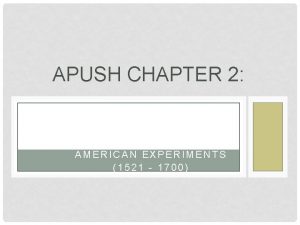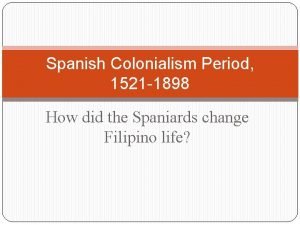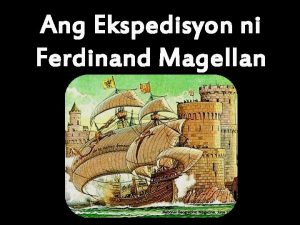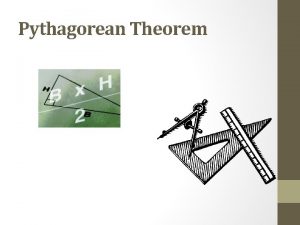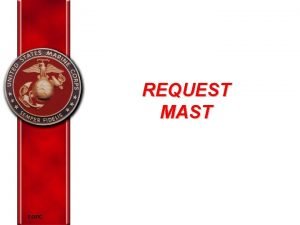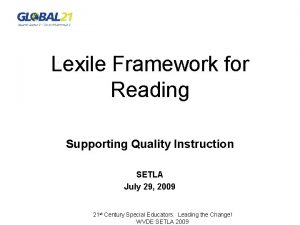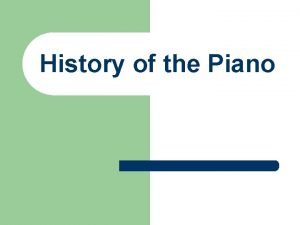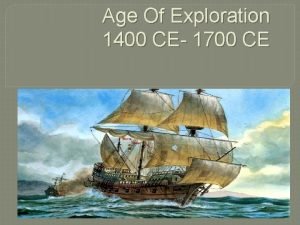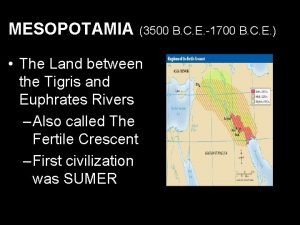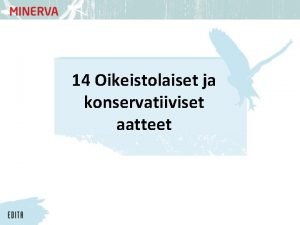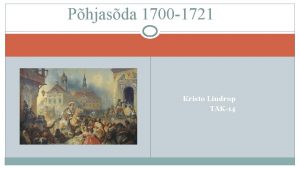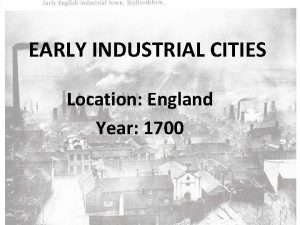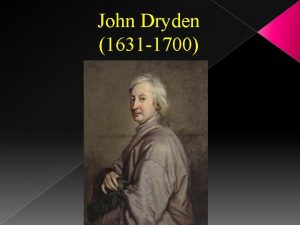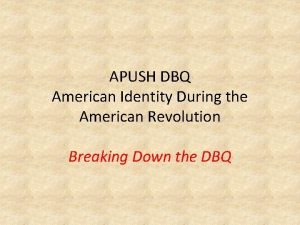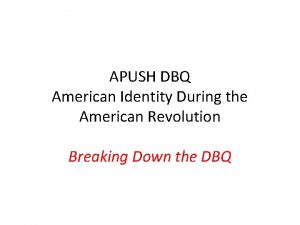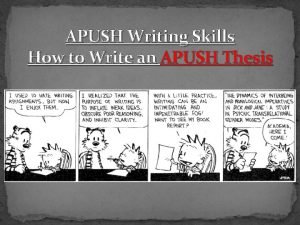APUSH CHAPTER 2 AMERICAN EXPERIMENTS 1521 1700 APUSH













- Slides: 13

APUSH CHAPTER 2: AMERICAN EXPERIMENTS (1521 - 1700)

APUSH STANDARDS • 1. 2 • 1. 3 • 2. 1

CHATTEL SLAVERY • Virginia and Maryland – 1660 s • Legally defined chattel slavery • The status of the child would be determined based on the MOTHER and not the FATHER • Ran contradictory to English law • Children born to slave owners and slave mothers were automatically slaves

SPAIN’S TRIBUTE COLONIES • A New American World: • Encomienda System – Spanish conquistadors received land from the crown • Based almost entirely on Indian slave labor • Very harsh, yet profitable • Spanish social classes: • Mestizos, Mulattos, and Zambos emerged • Many Spanish priests sought to convert Indians • The Columbian Exchange • Exchange of goods, people, disease, and ideas between Europe, Africa, and Americas • New crops were introduced to Europe – potato, maize • Horse had large impact on Indian life • In some areas, 90% of Indian population decreased • The Protestant Challenge to Spain • England began to build up its navy in the 16 th century • Mercantilism – purpose was to benefit the Mother Country (England) by exporting more goods than importing


PLANTATION COLONIES • Plantations in the Americas grew as a result of increased demand for sugar and tobacco • Brazil’s Sugar Plantations: • Very arduous labor, milling was done on site • As Indian populations declined, African slave labor was introduced • England’s Tobacco Colonies: • Jamestown: (1607) • Joint Stock Company (investors shared in profits and losses of colony) • Originally all men, hoped to gain gold • Eventually, tobacco became a major cash crop, but exhausted the land -> encroach on Indian land • House of Burgesses – first representative government in US (1619) • The Indian War of 1622: • 1/3 of Jamestown population was killed by Indian attacks, English retaliated • Jamestown became a royal colony in 1624 – colonists had to pay taxes to support the Church of England • Lord Baltimore Settles Catholics in Maryland: • Proprietor colony – royal grant of land granted by the King • Maryland Acts of Toleration (1649) – granted religious freedom to CHRISTIANS only, particularly Catholics • Maryland relied heavily on tobacco, like the other Chesapeake colony, Virginia

PLANTATION COLONIES CONT. • The Caribbean Islands: • Like Brazil, these colonies focused on sugar production • Plantation Life: • Planation's grew in part, due to the Headright System: • Gave 50 acres of land to someone who paid for an immigrant’s passage – benefited the rich • Indentured Servitude: • In return for passage, individuals would work 4 -5 years, then could be free • ½ of all servants died before they became free • Used extensively in the Chesapeake colonies in 17 th century • African Laborers: • Used more heavily in the Caribbean originally (sugar) • Used more in the Chesapeake due to Bacon’s Rebellion and it was cheaper than indentured servants • Strict laws developed that promoted racism and regulated behavior of blacks

NEW-EUROPEAN COLONIES • New France: • • Expanded into the North American interior (Canada) Quebec was established as a trading post (fur) Established Jesuit priests sought to convert Indians Coureurs de bois – French fur traders • New Netherland: • New Amsterdam (Manhattan) was a small colony, but engaged in significant commerce • Like the French, the Dutch traded furs • The Rise of the Iroquois: • Located in central and Western NY • Treaded weapons and goods with the Dutch and French • Remained a strong force in NY

NEW-EUROPEAN COLONIES CONT. • New England: • The Pilgrims • Separatists that wanted to break away from the Church of England • Plymouth’s climate was not as harsh as the Chesapeake • Representative self-government was established • Puritans – wanted to purify the English Church, NOT separate from it • John Winthrop and Massachusetts Bay: • Sought to establish a “City Upon a Hill” • Believed in predestination • Church members had tremendous power – only ones that could vote; not religiously tolerant • Roger Williams and Rhode Island: • Advocated separation of church and state, religious toleration, and friendly relations with Indians • Banished to Rhode Island by Winthrop • No legally established church in RI

NEW-EUROPEAN COLONIES CONT. • Anne Hutchinson: • • Seen as a major threat to Puritans Challenged gender roles in Church Claimed to have direct revelations with God Banished from MBC • Puritanism and Witchcraft: • Salem Witch Trials: • Hysteria throughout MA in late 17 th century • Accused tended to be wealthier, widowed, and middle-ages • Reflected religious and social tensions • Most of the accused were “independent” which challenged Puritan society • After the hysteria ended, prosecution for witchcraft declined • Many colonists started to embrace ideas of the Enlightenment

INSTABILITY, WAR, AND REBELLION • New England’s Indian Wars: • Puritan-Pequot War: • Pequots were allied with the Dutch, had conflicts with English settlers • 500 men, women, and children were massacred by Indians, New England retaliated harshly and gained land • Some settlers saw smallpox and other diseases that decimated Indians as doing “God’s work” (John Winthrop) • Metacom’s War, 1675 – 1676: • Metacom (King Philip) was a leader of the Wampanoags • Metacom was eventually killed and Natives were rarely a threat in New England after

INSTABILITY, WAR, AND REBELLION CONT. • Bacon’s Rebellion: • Gov. Berkeley did not allow settlement past a line • In the “west” many famers were underrepresented in the House of Burgesses • Conflict between Natives and “westerners” like Bacon • Bacon almost took control, died suddenly • Significance? • Movement towards slaves for labor • Shows tensions between rich and poor, East and West

QUICK RECAP • Columbian Exchange included diseases as well as goods (potatoes, maize, horses) • MD Acts of Toleration applied to ONLY Christians • Headright System and indentured servants • Chesapeake focused on indentured servants and tobacco expansion on Indian land • New France traded and had friendly relations with Indians • No religious toleration in MBC: Roger Williams and Anne Hutchinson • Bacon’s Rebellion showed tensions between “east and west” or “rich v. poor” and led to an increase in slavery
 Chattel slavery apush
Chattel slavery apush 1521 - 1898
1521 - 1898 Kanino inihain ni magellan ang balak niyang ekspedisyon
Kanino inihain ni magellan ang balak niyang ekspedisyon Similar pictures
Similar pictures Defines the request mast policy for marines
Defines the request mast policy for marines Lexile 1700
Lexile 1700 Nfpa 1700
Nfpa 1700 Piano 1700
Piano 1700 Christopher columbus significance
Christopher columbus significance Dynastic cycle def
Dynastic cycle def Eta 1700
Eta 1700 Rivoluzione agricola 1700
Rivoluzione agricola 1700 1700 luvun aatesuunta
1700 luvun aatesuunta Rotazione quadriennale rivoluzione industriale
Rotazione quadriennale rivoluzione industriale
